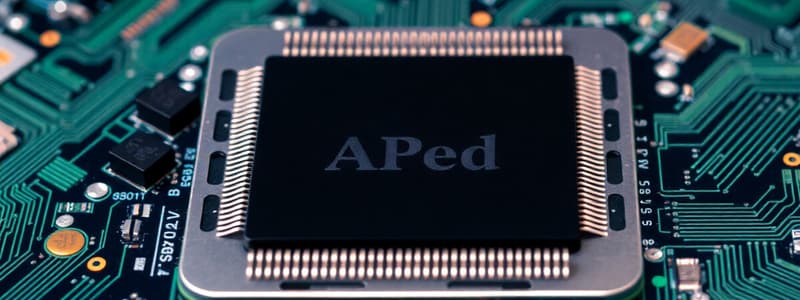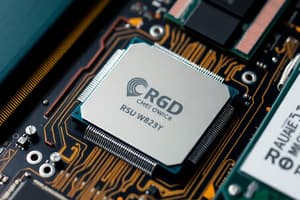Podcast
Questions and Answers
What is the primary function of the Control Unit within a CPU?
What is the primary function of the Control Unit within a CPU?
- Managing the flow of data between components (correct)
- Storing data for later use
- Displaying information to the user
- Performing mathematical calculations
Which of these is NOT a common type of computer storage?
Which of these is NOT a common type of computer storage?
- Optical Disc
- Flash Memory
- SSD
- RAM (correct)
What is the difference between a compiler and an interpreter?
What is the difference between a compiler and an interpreter?
- A compiler is used for high-level languages, while an interpreter is used for low-level languages.
- A compiler executes code line by line, while an interpreter translates it into machine instructions.
- A compiler converts source code into machine instructions, while an interpreter executes code line by line without prior compilation. (correct)
- A compiler translates code line by line, while an interpreter converts the entire code into machine instructions at once.
Which of these is NOT a common software license type?
Which of these is NOT a common software license type?
What is the role of the Motherboard in a computer system?
What is the role of the Motherboard in a computer system?
What is the primary function of a Graphics Processing Unit (GPU)?
What is the primary function of a Graphics Processing Unit (GPU)?
Which of these is NOT considered a peripheral device?
Which of these is NOT considered a peripheral device?
Which of these is a common example of application software?
Which of these is a common example of application software?
What is the term for errors in software code that can lead to unexpected behavior or crashes?
What is the term for errors in software code that can lead to unexpected behavior or crashes?
Which of the following best describes a data structure?
Which of the following best describes a data structure?
Flashcards
Central Processing Unit (CPU)
Central Processing Unit (CPU)
The 'brain' of the computer; performs calculations and controls operations.
Arithmetic Logic Unit (ALU)
Arithmetic Logic Unit (ALU)
Part of the CPU that performs mathematical calculations and logical operations.
Random Access Memory (RAM)
Random Access Memory (RAM)
Volatile memory that holds data currently in use; erased when power is off.
Solid State Drive (SSD)
Solid State Drive (SSD)
Signup and view all the flashcards
Input Devices
Input Devices
Signup and view all the flashcards
Operating System (OS)
Operating System (OS)
Signup and view all the flashcards
Compiler
Compiler
Signup and view all the flashcards
Software Bugs
Software Bugs
Signup and view all the flashcards
User Interface (UI)
User Interface (UI)
Signup and view all the flashcards
Data Structures
Data Structures
Signup and view all the flashcards
Study Notes
Unit 2: Computer Hardware
- Central Processing Unit (CPU): The "brain" of the computer; performs calculations, controls operations
- Components within CPU: Arithmetic Logic Unit (ALU) performs calculations, Control Unit manages instructions
- Types of CPUs: Differ in speed, architecture (e.g., x86, ARM), and core count
- Memory: RAM (Random Access Memory) holds currently used data; volatile (lost when power is off)
- Storage: Hard drives, SSDs (Solid State Drives), flash memory, optical discs store data; non-volatile (data remains when power is off)
- Input Devices: Keyboard, mouse, scanner, microphone; allow users to enter data
- Output Devices: Monitor, printer, speakers; display processed information
- Motherboard: Connects all computer components; houses CPU, memory, and expansion slots
- Graphics Processing Unit (GPU): Handles image processing and display; important for gaming and video editing
- Expansion Cards: Add extra functionality, such as sound or network capabilities
- Peripherals: Devices connected to the computer but not essential for basic function, like a printer or webcam
- Ports: Connections for peripherals (e.g., USB, HDMI, Ethernet)
- BIOS (Basic Input/Output System): Firmware that initializes the computer on startup; controls basic devices
- Power Supply Unit (PSU): Provides power to all computer components; its wattage must be sufficient for the system
- Bus Architecture: Data pathways between components; defines speed and communication limits
- Clock Speed: Measures the CPU's processing cycles per second, typically in GHz
- Word Size: Indicates the amount of data the CPU can process at once
Unit 3: Computer Software
- Operating System (OS): Manages computer hardware, software, and resources; examples include Windows, macOS, Linux
- Types of Software: Application software (e.g., word processors, games) and system software (e.g., operating systems, utilities)
- Application Software: Programs designed to perform specific tasks; examples include word processors, web browsers, games
- System Software: Manages computer resources; includes operating systems (OS), device drivers, and utilities
- Programming Languages: Used to develop software; examples include Python, Java, C++, JavaScript
- Software Development Lifecycle (SDLC): Process for creating software, including planning, design, implementation, testing, and deployment
- Software Licenses: Legal agreements governing the usage of software; may be shareware, freeware, trialware, open source, or proprietary
- Coding: The process of translating human-readable instructions into machine-executable code; software development is fundamentally about constructing effective code that processes algorithms and data
- Compiler: Converts source code into machine instructions; a crucial tool in translating higher-level language source code into machine code.
- Interpreter: Executes code line by line without prior compilation; a software tool that translates code into machine instructions in real-time.
- Software Bugs: Errors in software code that can lead to unexpected behavior or crashes; often fixed through updates or patches
- User Interface (UI): The way users interact with software; a good UI is essential for usability and user experience (UX)
- Data Structures: Organized ways of storing and managing data in software; essential for efficient program operation
- Algorithms: Step-by-step procedures for solving problems; the heart of program functions in software.
- Data Types: Determine type of information the software can store. Examples include integers, floating-point numbers, strings.
Studying That Suits You
Use AI to generate personalized quizzes and flashcards to suit your learning preferences.




